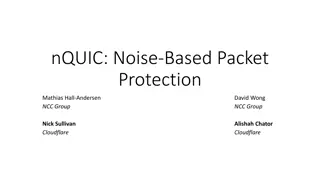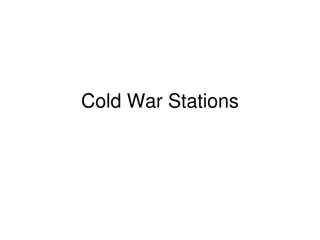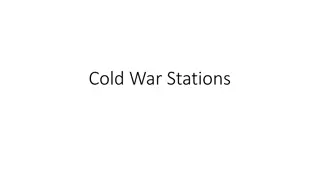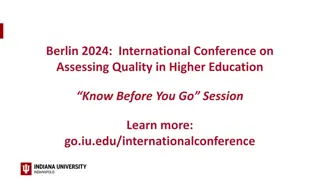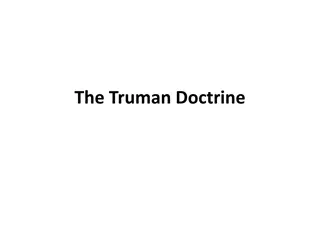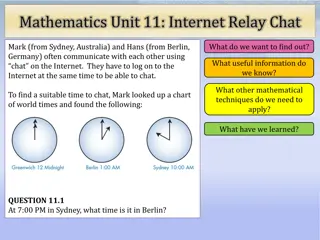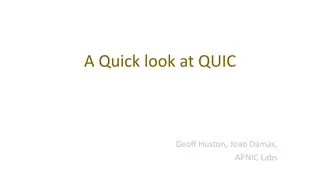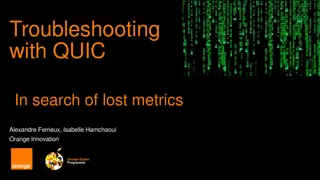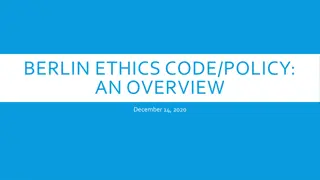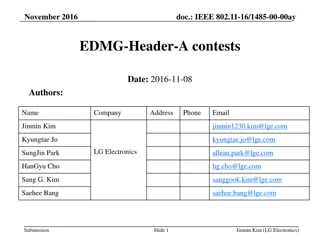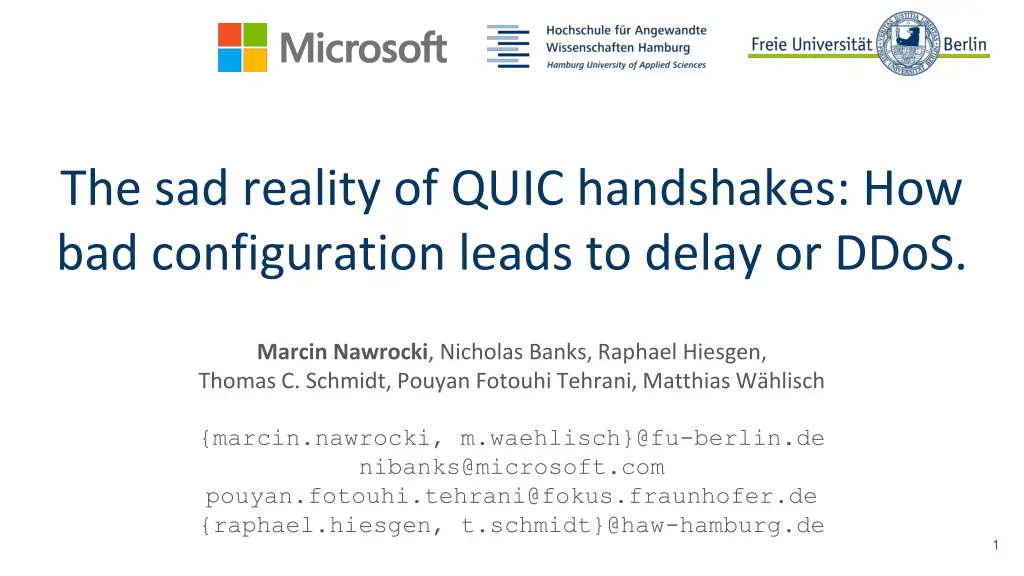
Sad Reality of QUIC Handshakes: Configuration Challenges
Understand the implications of QUIC handshake configuration issues leading to delays and DDoS vulnerabilities. Explore the design goals, implementation challenges, and practical repercussions faced in meeting these goals. Discover the impact of small vs. large QUIC INITIALs on round-trip times, reachability, and amplification risks. Dive into the causes behind multiple RTTs, including issues with RETRY tokens and TLS certificates.
Download Presentation

Please find below an Image/Link to download the presentation.
The content on the website is provided AS IS for your information and personal use only. It may not be sold, licensed, or shared on other websites without obtaining consent from the author. If you encounter any issues during the download, it is possible that the publisher has removed the file from their server.
You are allowed to download the files provided on this website for personal or commercial use, subject to the condition that they are used lawfully. All files are the property of their respective owners.
The content on the website is provided AS IS for your information and personal use only. It may not be sold, licensed, or shared on other websites without obtaining consent from the author.
E N D
Presentation Transcript
The sad reality of QUIC handshakes: How bad configuration leads to delay or DDoS. Marcin Nawrocki, Nicholas Banks, Raphael Hiesgen, Thomas C. Schmidt, Pouyan Fotouhi Tehrani, Matthias W hlisch {marcin.nawrocki, m.waehlisch}@fu-berlin.de nibanks@microsoft.com pouyan.fotouhi.tehrani@fokus.fraunhofer.de {raphael.hiesgen, t.schmidt}@haw-hamburg.de 1
Design goals of QUIC handshakes. Reduce round trip times. TCP/TLS/HTTP handshakes coalesced into 1RTT. Prevent UDP amplification attacks. RFC limits response size to 3x of an (unauthenticated) request. 3
In practice. Client Server Should be 3x INITIAL. Mainly steered by TLS cert. Under the control of the server. 4
Have the design goals been met? No! Configuration issue? Implementation issue! 7
How bad is the amplification? Not bad. Some implementations need bug fixes, though! 12
What causes multiple RTTs? RETRY tokens (DDoS prevention) Large TLS certificates (in conflict with the 3x limit) Only 2 domains. The majority! 13
85% of TLS data exceed the 3x threshold! This causes multiple round trip times. 14
What is the best-performing INITIAL size to not induce an additional RTT given current TLS certs? Currently, it is ~1350 bytes. Trade-off: Small INITIALs trigger multiple RTTs due to large TLS certificates. Large INITIALs reduce reachability because QUIC forbids IP fragmentation! 15
Recommendations to operators if you care about delay and DDoS prevention 1. Reduce the size of your TLS data! Be below 3x of common requests to fit into the 1RTT handshake. 2. Activate RETRY tokens! QUIC INITIAL DDoS floods are a rising threat vector! [ACM IMC 21] RETRY enables DDoS prevention for ZERO additional cost compared to current deployments (with multiple RTTs). 16
Test your QUIC server today! An open source tool. https://github.com/microsoft/quicreach 17
Check your QUIC / TLS deployment! 18
Backup 19
Are you saying we should increase the 3x limit? No. Let s first find out what a space-efficient but secure TLS config looks like. The 3x limit could encourage optimal configs. 20
How can you decrease your TLS data size? 1. Use algorithms with smaller signature footprint (elliptic instead of RSA). 2. We observe certificates with a long list of Subject Alt Names (SANs), reduce them! 3. This is a joint effort due to certificate chains. 21
Load balancers also add bloat! We are scanning top domains with a very large user base. Load balancers. Packet encapsulation is used between L4 and L7 load balancers (+20 bytes). 22
RFC 9000 and the 3x threshold for unvalidated clients 8.1. Address Validation during Connection Establishment Prior to validating the client address, servers MUST NOT send more than three times as many bytes as the number of bytes they have received. 17.2.5. Retry Packet An opaque token that the server can use to validate the client's address. 23
RFC 9000 and IP fragmentation 14. Datagram Size UDP datagrams MUST NOT be fragmented at the IP layer. In IPv4 [IPv4], the Don't Fragment (DF) bit MUST be set if possible, to prevent fragmentation on the path. 24
QUIC vs TCP certificate data. TLS data received over QUIC or TCP has roughly the same size. We observe ~100 bytes more with QUIC. 27



